As Kosovo marks the 20th anniversary of the attack against the Jashari family — often referred to as the beginning of the Kosovo War — we look at the story behind the ‘Epopeja.’
On Wednesday, soldiers in uniform and throngs of citizens dressed in national costume will gather in the village of Prekaz to carry torches for the Night of Fires. They will mark the end of the Epopeja e UCK-se (The Epic of the Kosovo Liberation Army, KLA), commemorating the three-day Attack on Prekaz, often referred to as the beginning of the Kosovo War.
In the attack, Serbian special police forces killed Adem Jashari—a founder of the KLA who was convicted in absentia of terrorism by a Yugoslav court in 1997—after several previous unsuccessful attempts. Fifty-eight others in the Jashari family were also killed in the attack, including several young children. Some of the family had volunteered to defend the Jashari compound after an earlier attack on January 22, 1998, which had left two of Jashari’s nieces wounded.
The family kulla remains almost as it was left after three days of shelling, though a structure was erected allowing visitors to walk around its exterior. Natural weathering, countless bullet holes, and even some high schoolers’ graffiti marks the home’s walls, which according to the village’s information center, have been visited by 12 million people during the past 20 years.
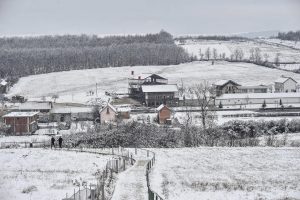
The village of Lower Prekaz. | Photo: Atdhe Mulla
On a recent Saturday, Lion Jashari, a “distant cousin” of the KLA commander, walked through Prekaz, the village and memorial he grew up in and still calls home, pointing out what has been added since he was a kid—a public square, white marble tombstones connecting the compound with a maroon-colored path, an information center.
He was only about four years old during the March 5-7 attack, and his family had fled the area during that time.
His childhood home sits directly across from the Jashari compound. About seven years earlier, before Lion Jashari was born, his father had flattened his body on the roof of the home, hiding from the gunfire of Serbian police who had surrounded Prekaz in an early attack on Adem Jashari. Lion’s father is now a veteran of the KLA.
Lion, now 23, stood on a hilltop housing Adem Jashari’s former bunker and pointed across the snow-dusted valley to the spot where he used to play soccer as a kid.
“I’m the only one of my generation who survived,” he said. But he emphasized that he also has a lot of happy memories of his childhood in Prekaz. With an UNMIK office in Skenderaj, the nearby city, foreigners from all around the world spent time in Prekaz, and he often played outside with their children. The rest of his days were spent reading and studying, especially mathematics. He now studies at the University of Prishtina for his MA in mathematics, and plans to get a PhD in economics.
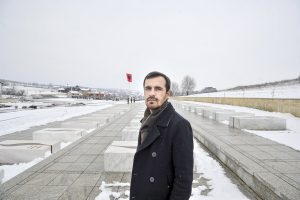
Lion Jashari walks alongside the mable tombstones of the 59 Jashari family members killed in the three-day attack. | Photo: Atdhe Mulla
The Municipality of Skenderaj is part of Drenica, seen as a region marked by resistance over the last century, since Azem Bejta, a nationalist born in Skenderaj under the Ottoman Empire who fought for the unification of Kosovo with Albania in the early 20th century, led the Kacak Movement against rule by the Kingdom of Serbia, and later the Kingdom of Yugoslavia.
Lion said that the region’s history is important to the story of Adem Jashari; he described a history of Albanian resistance in Drenica, and the struggle to build up the city of Skenderaj from Ottoman times to Yugoslavia.
“Ottomans tried to build a city here but the villagers burned it down,” he said. “Yugoslavia built up the city pretty late.”
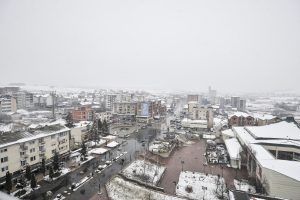
The city of Skenderaj. | Photo: Atdhe Mulla
Skenderaj, with its 53,000 residents, remains to be one of the poorest municipalities in Kosovo. Despite its low municipal revenues and the lack of proper access to drinking water in 23 of its villages, the area holds an almost mythical importance to the country’s history. In 2004, Kosovo passed a law making the memorial complex a site of national importance due to its “ontological, anthropological, historical and cultural and civic significance for Serbica/Skenderaj Municipality, Drenica, Kosovo and the wider Albanian nation.”
The three-day Attack on Prekaz is commemorated every year, and the memorial is visited by thousands of citizens, diaspora, and political tourists. Students are taught the story of Adem Jashari through history textbooks and school visits.
Bekim Blakaj, executive director of the Humanitarian Law Center Kosovo, HLC, was part of a team of researchers that documented the details of human loss during the Kosovo War. HLC has been a leading organization in establishing truth and facts about war events through their approach of gathering primary and secondary sources—such as watchdog reports, witness and survivor statements, and military documents—into a comprehensive database.
“This way of documenting victims doesn’t leave any space for manipulation with victims and their denial,” Blakaj told Prishtina Insight.
According to HLC’s research, Serbian Special Forces—including members of the Special Anti-Terrorism Unit, the Special Operations Unit, and the Special Police Unit—were involved in the March 5-7 attack. The Special Operations Unit was under the command of Milorad Lukovic, also known as Legija (the Legion), who was later convicted for planning the assassination of late Serbian Prime Minister Zoran Dindic.
Only after the attack on Prekaz was the case of Kosovo internationalized. Xhevat Imeri
Before dawn on March 5, 1998, Serbian forces took up positions on Prekaz’s hilltops, equipped with mortars, tanks, heavy artillery, cannons, and armoured vehicles mounted with machine guns.
Witnesses in the village heard the first sounds of an attack at around 6:30 am. According to HLC, “police were ordered to kill, indiscriminately, anyone, be it a child, woman or elderly person, who attempted to get out of or into the village.”
Adem Jashari’s family, including his parents, Shaban and Zaha Jashari, and the family of his brother, Hamez Jashari, gathered in Shaban’s family compound. Other homes of the extended Jashari family were also targeted; the families of Qazim Jashari, Sherif Jashari, Zuke Jashari, and Fejze Jashari gathered in Beqir and Halil Jashari’s home.
While shooting without interruption, police ordered the Jasharis to surrender. In the afternoon, the roof of Beqir and Halil’s home was destroyed by a mortal shell, and police threw tear gas into the house, calling on everyone to come out. Qazim emerged with hands above his head, but was shot and killed. Nazmi Jashari, disguised in women’s clothing and walking with his 70-year-old mother, was ordered to lay face down, and then was shot.
In the Shaban family compound, Adem’s wife, Adile, was killed while traveling between the basement and the first floor to bring ammunition to the fighters; some women in the Jashari compound had gone to the yard or upstairs to join the shooting. The family covered Adile’s body with a blanket and continued holding their defensive positions within the home.
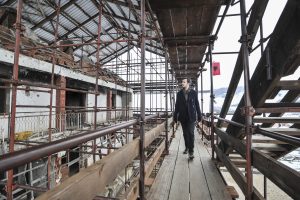
Lion Jashari’s home in Prekaz is down the road from the Adem Jashari memorial complex. Photo: Atdhe Mulla
The heaviest shelling took place on the morning of the third day of the attack, March 7, and by that time the house was completely destroyed by bullets and shells. Everyone hiding in the basement—except for 11-year-old Besarta, who hid behind a breadbox—was killed. Adem Jashari died while defending the basement.
As the sole survivor from the home where Adem Jashari’s closest family lived, Besarta Jashari, the daughter of Hamez, provided much of the eyewitness testimony established about the attack.
Fifty-nine members of the Jashari family were killed or declared as disappeared from the three-day attack. Several others outside of the family—two Serbian police members and around 10 people from surrounding villages—were also killed during the attack. Some were fellow KLA members who fought back, though others, civilians, were killed while hiding or attempting to flee.
A disabled man in Turiqec, described as “nearly paralyzed” by his surviving family members, was confident that due to his disability, the Serbian forces would not harm him. He stayed home while his family fled, but was later found killed in his bed. A father in Buroje hiding with his wife and children was shot while checking if the police forces had left the area around his home.
Another man in Turiqec was killed after going outside to feed his cattle. Serbian forces entered the home, forced his family members to leave, looted the home, and killed him. He was found buried in Klina and was not officially identified until 1999.
A day before the attack began, Serbian forces had parked two tanks near the home of a Roma family—Fatime and Bajram Gashi and their children—in Llausha, just down the road from Prekaz. On March 5, the forces parked a tank directly in their yard, and once shooting broke out, the Gashis and their children attempted to flee. Serbian forces opened fire and killed Fatime and two of her children: a girl and a boy, who had been holding his one-year-old sister.
On the morning of March 7, Serbian police began collecting bodies of the killed, and Goran Radosavljevic, a commander accused of intimidating witnesses and interfering with the Bytyqi brothers case, arrived to the scene.
Police took the bodies to a morgue in Prishtina before transporting them during the night back to Skenderaj and storing them in a warehouse. Police ordered family members to retrieve and bury the bodies, but survivors refused, demanding an international forensic investigation for evidence of the massacre. Days later, Serbian forces buried the bodies, which were later reburied by family members who held a joint ceremony in Prekaz, attended by tens of thousands of Albanians.
Human rights watchdog organizations immediately condemned the attack. Amnesty International (in report number EUR 70/33/98) emphasized that Serbian forces violated international norms and standards by using force to kill rather than arrest armed suspects, and that for Beqir Jashari’s home specifically, whether or not some of the family members were armed, “it is important to stress that in the witnesses’ accounts they had ceased to offer resistance and had effectively surrendered themselves to the police.”
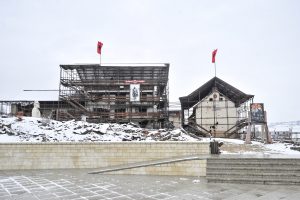
Visitors may walk around the Jashari family memorial complex, which preserves the site of the attack. | Photo: Atdhe Mulla
Though the events in Prekaz were later used by the International Criminal Tribunal for the former Yugoslavia to establish the existence of an armed conflict in the region overall, no one was sentenced specifically for crimes committed there.
The stories of victims outside of the Jashari family have not held as much weight in the public narrative. Still, the sheer violence of the attack and the high death toll, including women and children, undoubtedly drew international attention to atrocities being committed against civilians in Kosovo.
“Only after the attack on Prekaz was the case of Kosovo internationalized,” said Xhevat Imeri, a stoic man from upper Prekaz who works at the information center constructed in the village.
He describes himself as a narrator who has been telling the story of “the heroic resistance of the Jashari family for freedom” for the past 20 years.
“This family had everything one could dream of,” he said, motioning to refer to the family’s large kulla. “But they did not have freedom, so they sacrificed the most sacred thing in life, which is the family. It is an obligation for everyone to come here and visit the family, not because it is interesting but because it is a symbol of freedom.”
He also sees his job as a guide to the actual site of the attack as a way to establish truth.
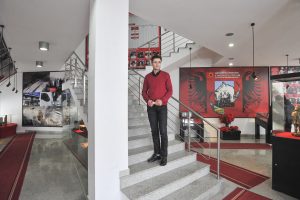
Xhevat Imeri has worked as a narrator in Prekaz for 20 years. | Photo: Atdhe Mulla
“It’s very important to have this here because there were internationals who could not be convinced about what happened; in their eyes, they could not imagine a small child being murdered,” he said. Lion Jashari chimed in to say that this was in large part due to Serbian propaganda.
The Kosovo state has put its efforts towards countering that narrative, for example by memorializing the Attack on Prekaz in public spaces, naming Prishtina’s airport after the ‘legendary commander,’ and most notably, through the annual three-day Epopeja.
Vjollca Krasniqi, professor at the University of Prishtina and the author of several works on public memory in Kosovo, has researched how national elites maintain and reproduce stories of martyrdom, family, and national tradition in their retelling of the attack.
In a 2014 publication, Krasniqi argues that “heroes personify the state” of Kosovo. The publication included a survey of about 1,500 people in Kosovo which found that Adem Jashari is “by far the most esteemed hero in the public mind,” with 60 per cent of Kosovo Albanian respondents regarding him as the “most important modern-day hero” (followed by late Democratic League of Kosovo leader Ibrahim Rugova with 10 per cent). Forty-eight per cent of respondents said that the Jashari family memorial site is Kosovo’s most important monument.
The lines between civilians and soldiers are blurred in Prekaz. Vjollca Krasniqi
“Political entrepreneurs have made [Prekaz] a space for them to tell a particular story, which has become a national story of national struggle,” Krasniqi said during a recent conversation in her office.
The story is simultaneously about victimhood, martyrdom and resistance. Reports referenced in ICTY trials found that some men were summarily executed, shot at close range. Women and children were among the victims. Though the town’s narrators do not fail to emphasize the brutality of the attack, they are also not shy about framing it as an intentional sacrifice.
“Because [Hamez and Adem Jashari] knew they were going to have to fight for survival, they had each sent one child, sons, to Germany after the first attack in 1991,” narrator Imeri explained, saying that the family prioritized the continuation of the patriarchal ‘bloodline.’ “Before the second attack [referring to the period between January 22 and March 5-7, 1998], they were advised that their wives and children should flee, but there was an agreement with them that ‘if our men are going to die, what’s the point?’”
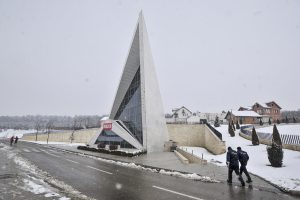
Prekaz’s narration center, which currently serves as a museum. The narration center says that a lack of investments has hurt conservation efforts in the village. | Photo: Atdhe Mulla.
Krasniqi explores the gendered and nationalist symbolism of Prekaz in her research. The aesthetic choices in the memorial site and the country’s narration of the events all emphasize that the Kosovo Liberation Army’s war was a just war, she said.
“The lines between civilians and soldiers are blurred in Prekaz,” she said.
Krasniqi said the memory of Jashari is also deeply linked to the Democratic Party of Kosovo, PDK, and the Association of War Veterans, who she argues have been main actors commemorating him as a national hero and symbol of freedom and independence. For Kosovo’s declaration of independence, the government sponsored banners and billboards around the capital with an illustration of Adem’s face and the slogan Bac, u kry! (Uncle, it’s done!).
PDK built its party-identity around the Epopeja of the KLA and maintained power in Kosovo for ten years in large part due to the loyal voter base from Drenica.
The Municipality of Skenderaj is now run by Bekim Jashari, nephew of Adem, who was elected mayor last year. Jashari ran as an independent, unopposed by PDK. He replaced PDK strongman Sami Lushtaku, who had kept the mayoral seat even while indicted for war crimes (for which he was first convicted and later acquitted).
While locals stress to the government that a lack of financial investments threatens proper conservation of the monument, Kosovo elites seem to be reeling in anxiety that the entire framing of KLA’s war is under threat. In December, President Hashim Thaci pardoned three former KLA members convicted of a ‘revenge killing,’ just days after governing party MPs tried to repeal the law on the ‘Special Court,’ tasked with prosecuting crimes allegedly committed by KLA members during and after the war (MPs later abandoned these efforts after Quint States reacted harshly).
President Thaci said that though the law “cannot be revoked,” he maintains that it was imposed on Kosovo by the west, and that its establishment constitutes a “historic injustice” towards Kosovo. When talking about the ‘Special Court,’ he repeatedly emphasizes that the Kosovo liberation war was a just war–a sentiment even established in a Kosovo Assembly resolution in 2016.
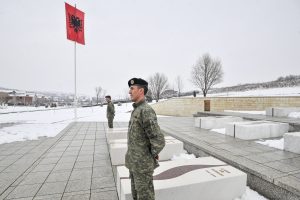
Kosovo Security Force members stand beside the graves of Adem Jashari, his brother Hamez Jashari, and father Shaban Jashari. | Photo: Atdhe Mulla
In her office at the university, professor Krasniqi said that these arguments against the legitimacy of the Specialist Court are tied to the political retelling of commander Jashari’s resistance.
“This [framing] of the liberation war as a just war keeps repeating every time,” she said.
A new era began with the Jashari family, said Kosovo Prime Minister Ramush Haradinaj before he visited Prekaz for the Epopeja. With ‘Special Court’ indictments imminent, his message mirrors that of the narrator back at the Jashari museum: the KLA’s war was just, a resistance movement that liberated the nation.
Eve-anne Travers contributed to this article.





